The Merced River is a tributary of the San Joaquin River in central California. The 145-mile-long river flows from the agricultural plains of the San Joaquin Valley in Merced County to the Yosemite Valley in Mariposa County. However, the Merced River is best known for swiftly running through Yosemite National Park. Of the many animals in the park, the snakes of Merced River are misunderstood and underappreciated.
Yosemite National Park is a massive and biodiverse nature preserve home to 22 different reptile species,13 of which are snakes. With a glaciated landscape yet plenty of volcanic and metamorphic rocks along the Merced River and its watershed, snakes play a key role in the park and the river’s delicate ecosystems. Here are the 13 snakes of the Merced River.
1. Common Garter Snake
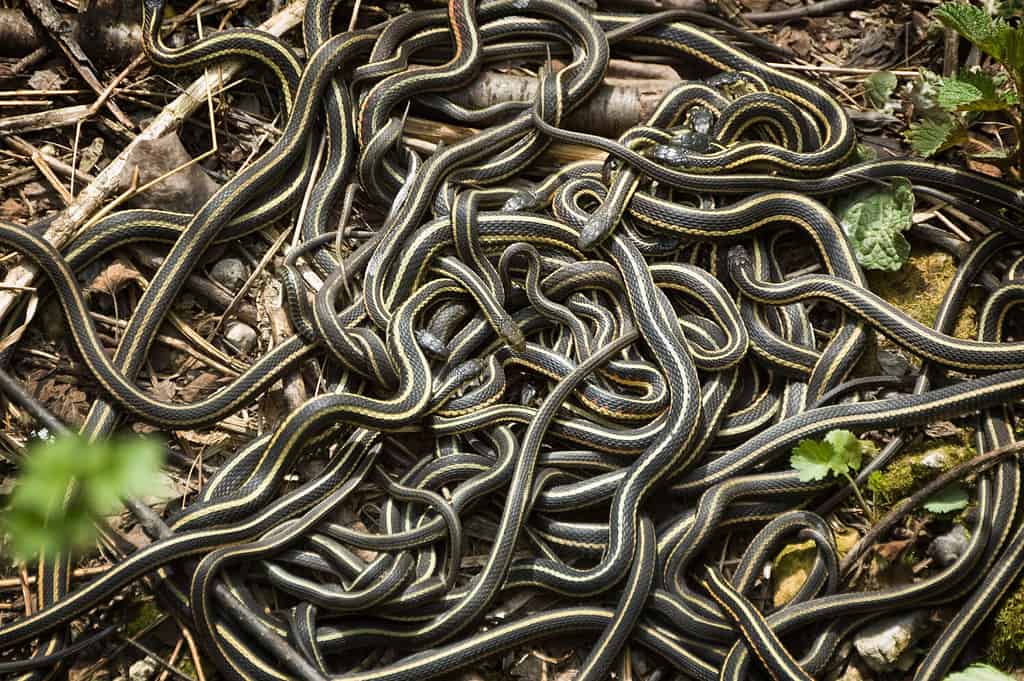
Garter snakes give birth to large litters and form equally large dens in moist environments.
©Cindy Creighton/Shutterstock.com
Most of the snakes you can find in the Merced River are garter snakes. The common garter snake (Thamnophis sirtalis) is a regular sight in Yosemite National Park and the riverbeds, along with two other garter snake species.
Many other types of snakes, like colubrids and rattlesnakes, are present in the park and Merced River. You’ll find an overwhelming number of garter snakes because garter snake species are especially fecund. Unlike most snakes, they reproduce through live birth with 30-40 babies born at a time.
Common garter snakes can be easily differentiated from the other garter snakes of the Merced River. Most of them have three light stripes that run along their bodies, with darker skin underneath.
The common garter snake thrives in wet environments like streams, wetlands, marshes, and ponds. These snakes are adept at catching fast aquatic prey like fish and tadpoles. They also like insects, leeches, slugs, snails, and earthworms, among the other invertebrates they can find along the Merced River’s shores.
If You Encounter This Snake
Garter snakes are harmless. If you want to fish in the Merced River, Lake Merced, or any ponds, they are more likely to slither away than attack. Since garter snakes give live birth, you don’t need to worry about disturbing eggs or nests. However, they still have a nasty bite if you come into contact with one. Garter snakes have weak venom that only incapacitates smaller animals rather than humans. However, their bites can be severe enough to require medical attention.
2. Sierra Garter Snake
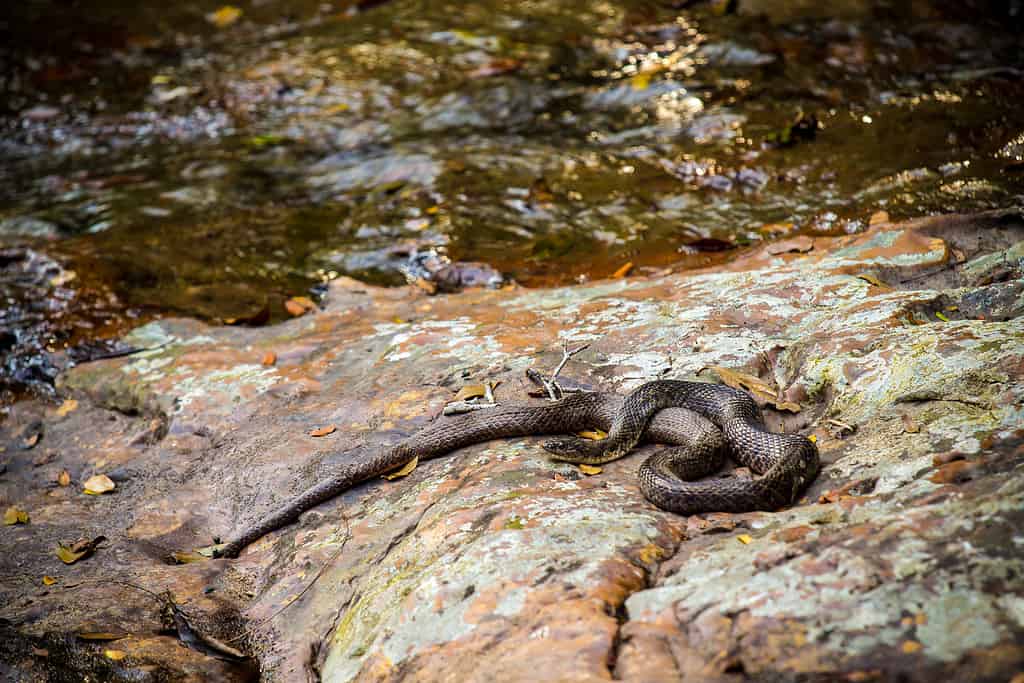
Sierra garter snakes are strong swimmers and spend lots of time in and near water.
©t_cherdchay/ via Getty Images
Also known as Couch’s garter snake, the Sierra garter snake (Thamnophis couchii) easily differentiates itself from its common garter snake cousin. Garter snakes love water as it is, but the Sierra garter snake is even more aquatic.
With a longer and thicker body than the common garter snake, the Sierra garter snake can swim through the rough waters of the Merced River. This snake easily adapts to streams and riverbeds, where it dines on amphibians like frogs, toads, and salamanders with some fish for variety.
The larger and longer body is usually the first way to tell the difference between the Sierra garter snake and other garter snakes. It also often lacks those distinctive stripes common garter snakes have. Its markings may be dark spots or muted stripes.
If You Encounter This Snake
As is the case with common garter snakes, the Sierra garter snake isn’t apt to hurt you unless you disturb its habitat. Since these snakes are powerful swimmers, you might see one in the water if you go rafting. It’s best to leave it alone since they have long, curved teeth and mild venom.
3. Western Terrestrial Garter Snake
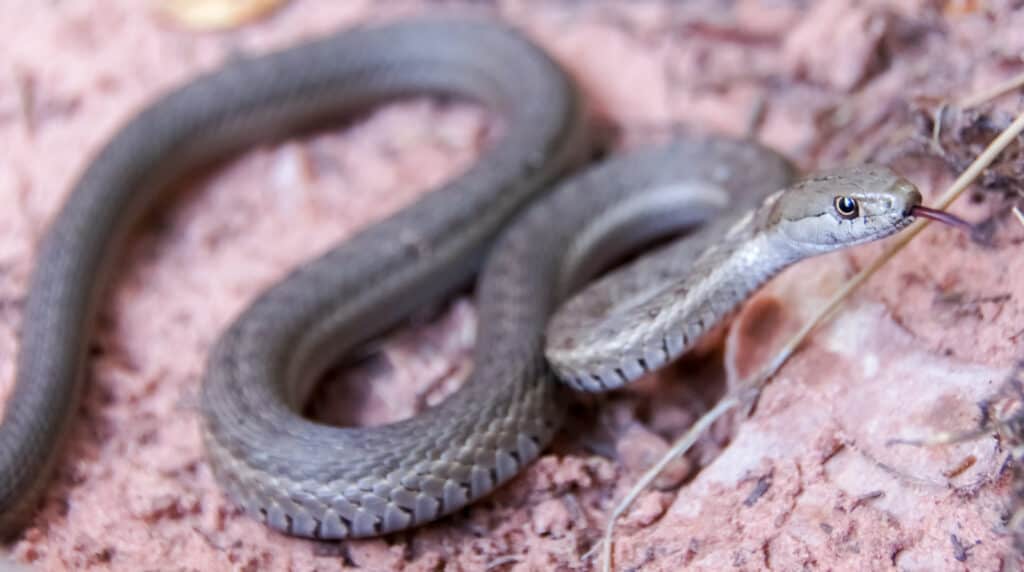
The western terrestrial garter snake thrives in rocky habitats near rivers and lakes.
©iStock.com/yhelfman
Of the three garter snake species living near the Merced River, the western terrestrial garter snake (Thamnophis elegans) is the most challenging for both reptile hobbyists and professional herpetologists. There are so many variations of the western terrestrial garter snake that it can be difficult to correctly identify them. At least six subspecies have been identified, such as the mountain garter snake and San Pedro Mártir garter snake. These snakes can be incredibly colorful or black or dark brown with red, yellow, orange, or white dorsal and side stripes.
The western terrestrial garter snake thrives in almost any elevation, which is why they take so well to Yosemite. It produces much smaller broods than the common garter snake, only about 8-12 baby snakes, so you won’t see this snake as often. As the name implies, this snake prefers terrestrial environments and doesn’t spend as much time in the river as its cousins. Western terrestrial garter snakes eat similar prey like amphibians, fish, and insects, but they also eat terrestrial animals like small mammals and lizards. 3
The western terrestrial garter snake is the only garter snake species known to constrict prey. Their constriction isn’t as effective as a boa or gopher snake.
If You Encounter This Snake
As is the case with the other garter snake species of the Merced River, the western terrestrial garter snake is harmless. Unlike its cousins, however, its venom is slightly more potent. Their venom is unlikely to hurt humans, but their bite can puncture skin.
4. Pacific Gopher Snake

Pacific gopher snake also known as the Coast gopher snake is native to the Merced River.
©Eric Isselee/Shutterstock.com
Often mistaken for a rattlesnake because of their diamond pattern and similar defensive behaviors, the Pacific gopher snake (Pituophis catenifer catenifer) is a close relative of the bullsnake. They’ll even vibrate their tails similarly! They’re also among the largest snakes in Yosemite, topping out around 4 feet.
They get their name from gophers being their favorite snack. Pacific gopher snakes are a crucial part of the Merced River’s ecosystem because they keep the rodent population in check. They borrow nests from gophers and ground squirrels to have a safe place to lay eggs and an automatic food source.
If You Encounter This Snake
The Pacific gopher snake can be mistaken for a rattlesnake. While you’ll want to give both snakes their space, you can tell the two apart by the tail. Gopher snakes don’t have black and white bands on their tails, or rattles for that matter. They also have smaller and narrower heads compared to rattlesnakes.
Unlike rattlesnakes, Pacific gopher snakes are not venomous. They will puff up and vibrate their tails in a defensive pose but will not strike with bared teeth like a rattlesnake. They keep their mouths closed. You’re likely to encounter one by accident in a pile of leaves. If this happens, back up and show you’re not a threat. This can calm the snake down, even making it possible to handle. You should only do this if you have experience handling large reptiles.
5. Northern Rubber Boa

The northern rubber boa curls up into a ball as a defense mechanism.
©yhelfman/Shutterstock.com
The northern rubber boa is a rare sight in Yosemite. Most boas live in Central and South America; the northern rubber boa is the northernmost boa species. Like the garter snakes, they give live birth but have tiny broods of 1-5 babies. Female rubber boas only reproduce up to every four years. They are also only active at dusk and dawn, making them harder to observe in the wild.
This snake is the closest you will get to encountering a ball python in the wild, and ball pythons are the most docile snakes. Just like ball pythons, rubber boas curl up into a ball as a defensive mechanism. This is, unfortunately, ineffective against coyotes, birds of prey, or even raccoons. Raptors and other large birds that drink from the Merced River often make a meal of this snake.
In turn, the northern rubber boa is not much of a predator. They eat snake, lizard, and bird eggs, along with young mammals like baby mice. When navigating the riverbanks, rubber boas also eat salamanders and frogs.
If You Encounter This Snake
If you have the incredible luck of seeing a northern rubber boa, it is extremely unlikely to hurt you. Like a ball python, it will just curl up in a ball, and it isn’t venomous. Subsequently, you might be able to handle one lightly, but they’re apt to slither away from groups of humans.
6. California Kingsnake
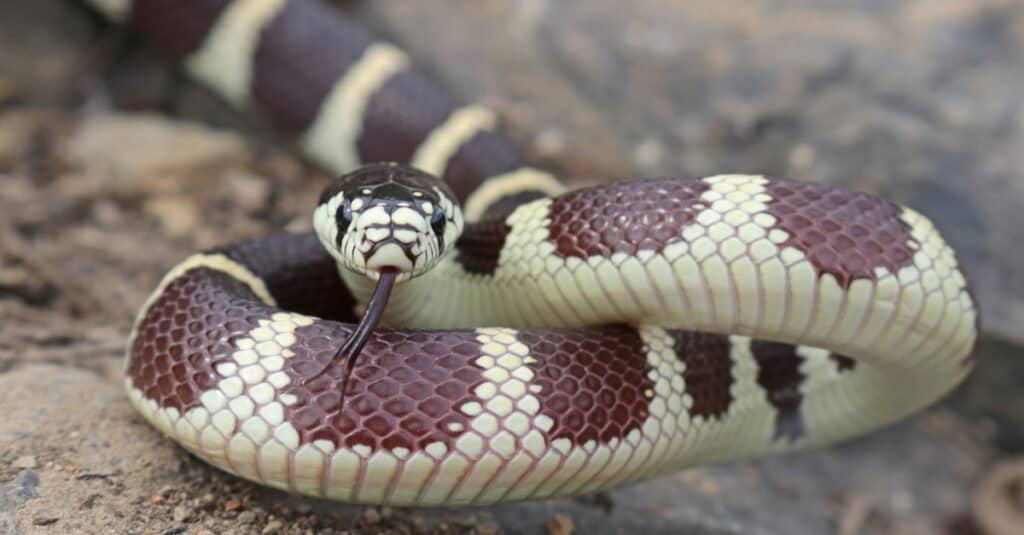
California kingsnakes have exquisite dark and light band patterns that can vary significantly in even the same clutch of eggs.
©Creeping Things/Shutterstock.com
The California kingsnake (Lampropeltis californiae) is a very distinctive snake with a long, thin body of alternating dark and light horizontal bands. Kingsnakes are incredibly gentle, which is why they’re popular in the reptile hobby.
The California kingsnake is an opportunistic feeder. It eats rodents, birds, lizards, and amphibians along the Merced River banks. While far from the only reptile that eats other reptiles, the California kingsnake is known to eat rattlesnakes. While they prefer a ground squirrel dinner or a toad, these snakes target rattlesnakes over other snakes when food is scarce. California kingsnakes are immune to rattlesnake venom despite lacking venom themselves.
California kingsnakes use powerful constriction to kill their prey. Relative to body size, this makes them even more powerful than boa constrictors.
If You Encounter This Snake
California kingsnakes are incredibly gentle. You’re most likely to find one in a pile of leaves, and it will bluff being a bigger and more powerful snake. While it will calm down in a few minutes, you still risk a minor bite if you handle it. Kingsnakes will also release a smelly musk and their cloacal contents as a defense mechanism, so you risk smelling of snake poop the entire hike.
7. Coral-Bellied Ring-Necked Snake
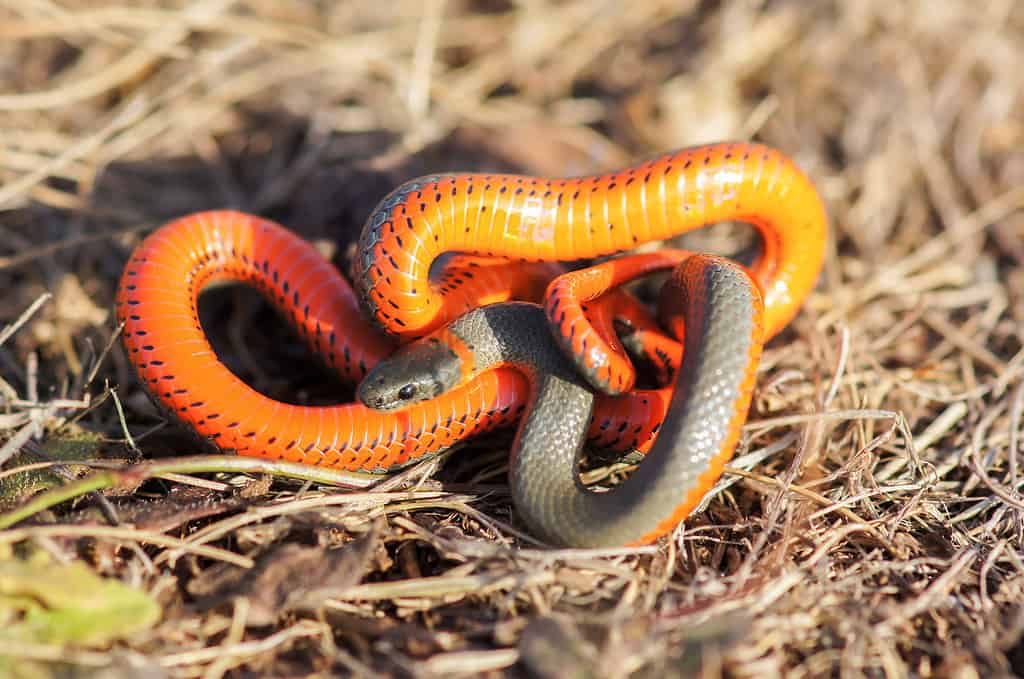
Diadophis punctatus acricus snake.
©iStock.com/yhelfman
The coral-bellied ring-necked snake (Diadophis punctatus pulchellus) is a distinctive colubrid that is easy to identify. Just look for a gray back, a bright coral-red belly, and a small black head separated by an orange band (its ring).
Many other variants and subspecies of ring-necked snakes are found throughout California and other parts of North America. The coral-bellied variety is seen the most in inland California. This snake loves to burrow in moist areas, like riverbanks and the wet areas of woodlands. Coral-bellied ring-necked snakes can live at higher elevations in hilly areas like Yosemite. They prefer lower elevations where they can build snake dens that get warmer than their body temperature.
Ample cover like leaves, dead wood, and woodland scraps are important parts of building a proper snake den. Coral-bellied ring-necked snakes prefer to share their dens with other snakes but live alone if they need to. Maintaining a proper forest floor is crucial for these snakes to contribute to the Merced River’s ecosystem.
These snakes eat prey that thrive in moist riverbanks, like salamanders, worms, froglets, and tiny tree toads. They will also feast on baby snakes if food is scarce.
If You Encounter This Snake
The coral-bellied ring-necked snake is as long and thin as a drinking straw. They’re incredibly fast and likely to run from humans. Even if you catch one, they aren’t likely to bite you and can be lightly handled. Their venom isn’t strong enough to hurt humans.
8. Western Blue Racer

This blue racer snake’s scales have a rare blue sheen.
©Psychotic Nature/Shutterstock.com
Of the different colubrids found along the Merced River, the blue racer snake (Coluber constrictor foxii) is among the most distinctive. Many North American racer subspecies are spotted in and near Yosemite, but the blue racer snake is a rare treat.
Blue snakes of any type are rare, and the blue racer snake is easy to identify based on its white belly with blue scales on top. The blue scales can be anywhere from gray-blue to bright light blue.
Blue racer snakes are opportunistic eaters and adaptable to different environments with a preference for bodies of water. They eat insects, frogs, toads, and rodents plus smaller reptiles like turtles, lizards, and other snakes. Racers like to be near water like the Merced River, but they are skilled climbers capable of scaling trees to eat bird eggs and young birds. Despite having “constrictor” in their scientific name, blue racer snakes don’t use constriction.
In turn, owls and raptors like to dine on blue racer snakes.
If You Encounter This Snake
Blue racer snakes are harmless. They aren’t venomous and are more likely to slither away if they encounter a much larger creature like a human. However, if you try to handle one in the wild, they are likely to bite you. Blue racer bites usually don’t require medical attention, but it’ll hurt.
9. Alameda Whipsnake
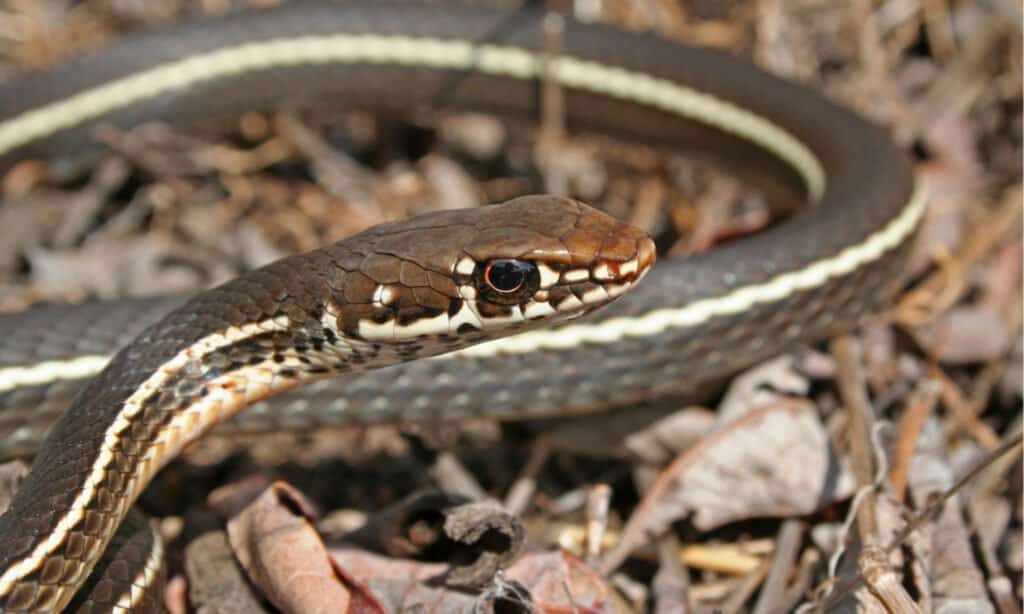
Alameda whipsnakes have distinctive pale yellow stripes.
©Creeping Things/Shutterstock.com
The California whipsnake (Masticophis lateralis) lives in many different biomes in California. This colubrid is very similar to racer snakes appearance-wise. The California whipsnake prefers arid areas and navigating brush to find prey and avoid predators.
The Alameda whipsnake was known as the California striped whipsnake. It is distinguished by the yellow stripes running down its sides that contrast its orange and black body. Endemic to the Yosemite area, the Merced River watershed is the only place to find Alameda whipsnakes.
Alameda whipsnakes come to creeks and riverbanks to feast on small mammals and insects. Their favorite food is small lizards like western fence lizards, but they also eat rattlesnakes.
If You Encounter This Snake
The Alameda whipsnake is endangered, and seeing one in the wild is incredibly rare. They are not venomous or apt to severely hurt you. However, they do not like handling and will live up to their name by tail-whipping you.
10. California Night Snake
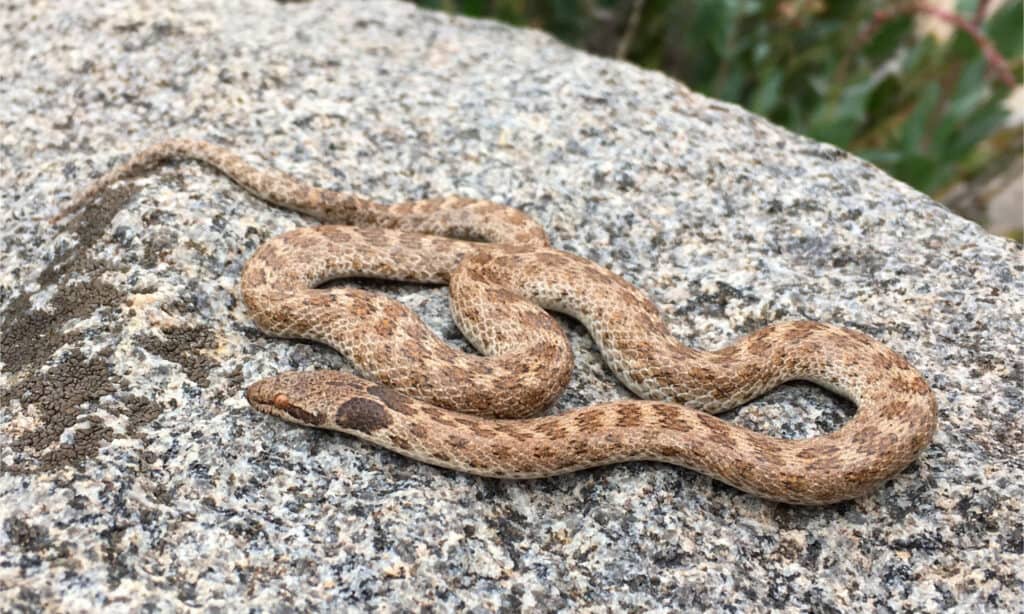
The California night snake prefers to hide under rocks during the day.
©Matt Jeppson/Shutterstock.com
The California night snake (Hypsiglena ochrorhynchus nuchalata) is also known as the spotted night snake and San Diego night snake. It is a small colubrid with coloration designed to blend in with its habitat. They are roughly the same size as a ballpoint pen.
As the name implies, these snakes are nocturnal. They like to hide under flat rocks and prey on small lizards and snakes. It is rare to encounter one near the Merced River, where they eat young lizards and soft insects at night.
If You Encounter This Snake
Since the California night snake only comes out at night and is incredibly small, you are unlikely to see one at all. People who find them during the day only accomplish this by picking up large flat rocks. Moving large rocks in the wilderness disrupts natural habitats, so they should be left alone.
In the rare event you encounter a California night snake, it’s harmless and apt to quickly slither away. If you manage to catch one, it will be angry but won’t cause a serious injury.
11. Sharp-Tailed Snake

The sharp-tailed snake is easily identified by the extremely sharp end of its tail.
©Bill Bouton / CC BY-SA 2.0 – License
The sharp-tailed snake (Contia tenuis) is the world’s smallest colubrid. It’s also the smallest snake species found along the Merced River. Also known as a worm snake, the reddish-brown sharp-tailed snake is shorter than a standard necklace chain: 12-18 inches.
The sharp-tailed snake lives up to its name because its tail tapers into a sharp point like a skewer. The scales around its tail transform into a sharp spine.
This snake uses its sharp tail like a fork to eat spaghetti. Because of its small size, the sharp-tailed snake subsists off of slugs, worms, and slug eggs. The spine on its tail stabilizes the soft, juicy slugs so it can eat more easily.
Being such a small snake, sharp-tailed snakes are prey for lizards, frogs, and larger snakes like racers.
If You Encounter This Snake
Sharp-tailed snakes are harmless and reclusive. It prefers the cover of leaf litter, large rocks, and snake dens to hide from its many predators. Soft, moist soil is a preferred burrowing spot, which is why sharp-tailed snakes often appear near the Merced River. Because these snakes are small enough to be mistaken for worms, they can’t hurt humans. If you do find one, it will slither away quickly.
12. California Mountain Kingsnake

California mountain kingsnakes get mistaken for coral snakes due to similar patterns and colors.
©Matt Jeppson/Shutterstock.com
The California mountain kingsnake (Lampropeltis zonata) is a colubrid that looks almost exactly like a deadly coral snake. However, this colubrid is totally harmless.
There are several subspecies of the California mountain kingsnake. This snake is easy to identify based on its bright coral-red, white, and black horizontal bands.
California mountain kingsnakes thrive on rocky slopes near bodies of water like Mirror Lake and the Merced River. Like their other kingsnake cousins, they like to eat rattlesnakes and feast upon skinks and other small lizards. They also eat rodents; their favorites are the mice and gophers in the woodlands near the river.
If You Encounter This Snake
Like other kingsnakes, the California mountain kingsnake is very gentle. They are popular in the reptile hobby for their docile temperant and beautiful colors. While you shouldn’t take this snake home as a pet, they are amenable to some handling in the wild and unlikely to bite you.
They aren’t venomous, unlike the coral snakes they mimic. There are no coral snakes in the San Joaquin Valley, so you won’t handle an extremely venomous snake by mistake.
13. Northern Pacific Rattlesnake
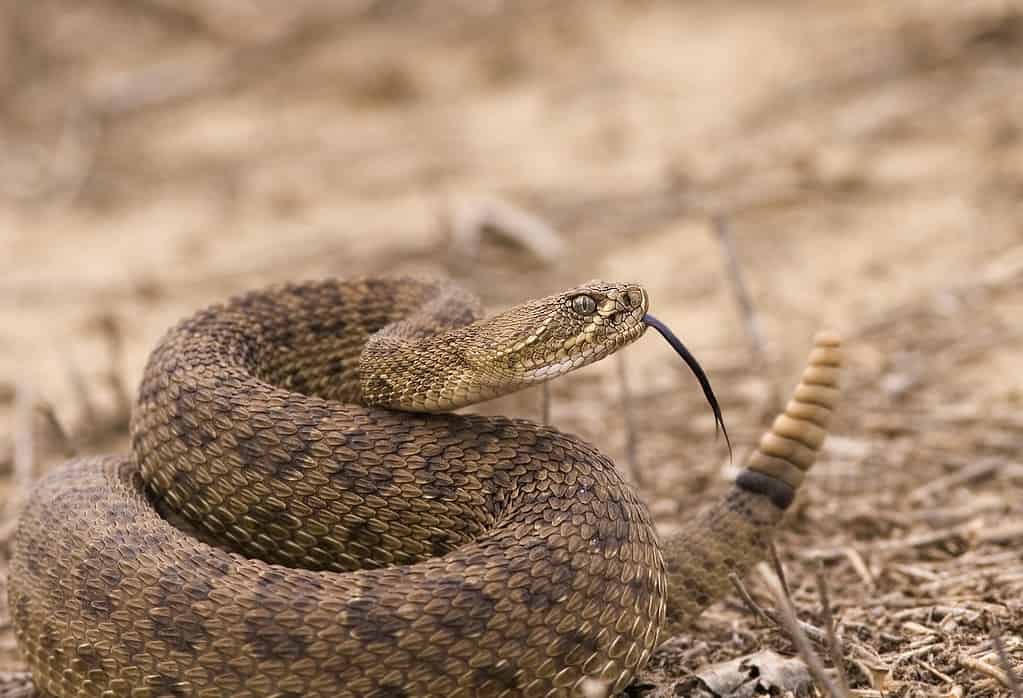
Western rattlesnakes coil before they strike, even if you can’t hear them rattle.
©Steve Mcsweeny/iStock via Getty Images
The western rattlesnake, more recently called the Northern Pacific Rattlesnake (Crotalus oreganus), is the only venomous snake in Yosemite. A type of pit viper, these snakes have long been feared for their venom, which is known to cause health problems in humans. While they rattle their tails as a menacing warning, these snakes actually aren’t that big: only about as long as a yardstick.
The western rattlesnake uses its facial pits to detect heat and locate prey. Small mammals like rodents and rabbits are this snake’s favorite foods. They also eat birds, eggs, lizards, and amphibians that live in the Merced River and near its banks. Western rattlesnakes have natural predators like kingsnakes, bobcats, coyotes, and birds of prey that are resistant to their venom.
Like garter snakes, rattlesnakes give live birth instead of laying eggs, but they aren’t as fecund. You aren’t likely to encounter massive dens of western rattlesnakes because they don’t breed in such huge numbers.
If You Encounter This Snake
Western rattlesnakes do have potent venom. They also don’t always audibly rattle their tails as a warning before they strike, but they do coil. These snakes don’t run after humans, so if you see one from a distance and stay far away, you should be fine. Your biggest risk in encountering a western rattlesnake is accidentally stepping on one, then it bites you in retaliation.
While a rattlesnake bite is hardly a desirable outcome, the good news is that western rattlesnakes conserve their venom for prey. Humans are too big to be appetizing prey for a three-foot snake. There’s only a 30-40% chance the bite will inject venom. Although for most people, that’s 30-40% too high.
If you want to mitigate this risk, don’t put your hands near cracks and holes in rocks when taking a rest. You should also pack first aid kits with anti-venom treatments. Make sure you know how to properly use them before your adventure, especially if you’re going off the beaten path. Staying on the main trails with more people reduces your chances of finding rattlesnakes.
| Rank | Snake |
|---|---|
| 1 | Common Garter Snake |
| 2 | Sierra Garter Snake |
| 3 | Western Terrestrial Garter Snake |
| 4 | Pacific Gopher Snake |
| 5 | Northern Rubber Boa |
| 6 | California Kingsnake |
| 7 | Coral-bellied Ring-necked Snake |
| 8 | Western Blue Racer |
| 9 | Alameda Whipsnake |
| 10 | California Night Snake |
| 11 | Sharp-Tailed Snake |
| 12 | California Mountain Kingsnake |
| 13 | Western Rattlesnake |
The photo featured at the top of this post is © Jukka Palm/Shutterstock.com
Discover the "Monster" Snake 5X Bigger than an Anaconda
Every day A-Z Animals sends out some of the most incredible facts in the world from our free newsletter. Want to discover the 10 most beautiful snakes in the world, a "snake island" where you're never more than 3 feet from danger, or a "monster" snake 5X larger than an anaconda? Then sign up right now and you'll start receiving our daily newsletter absolutely free.
Thank you for reading! Have some feedback for us? Contact the AZ Animals editorial team.






